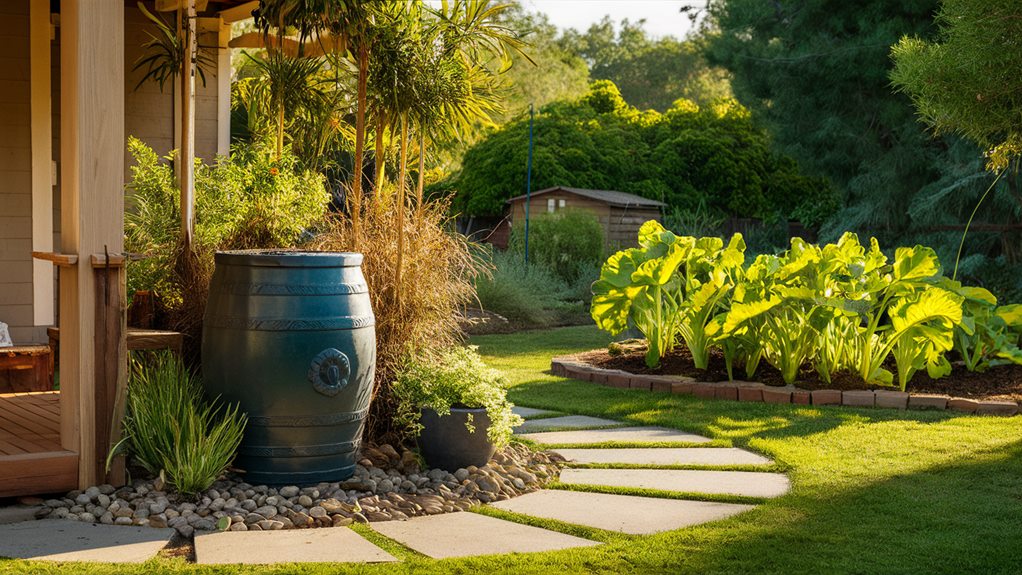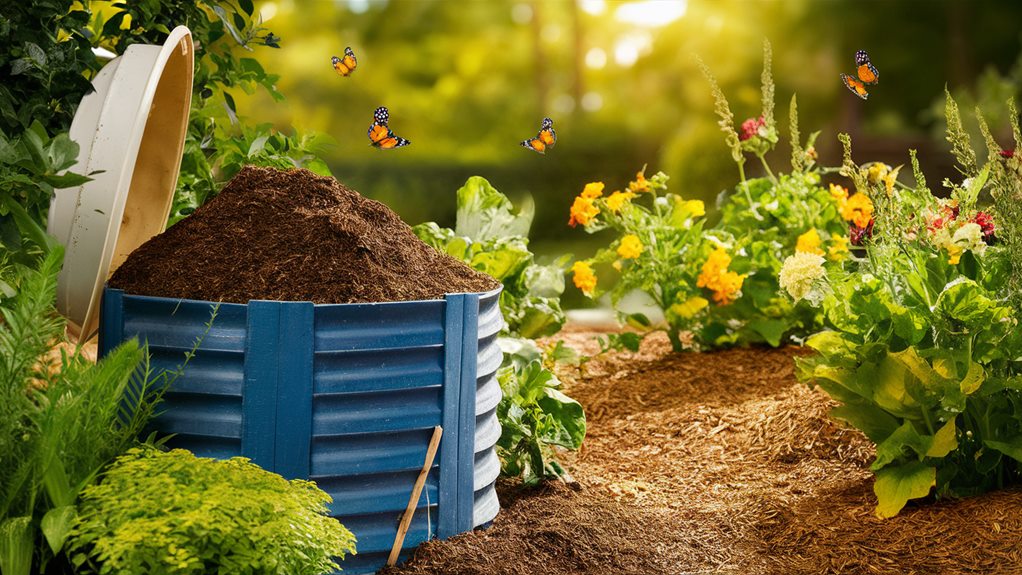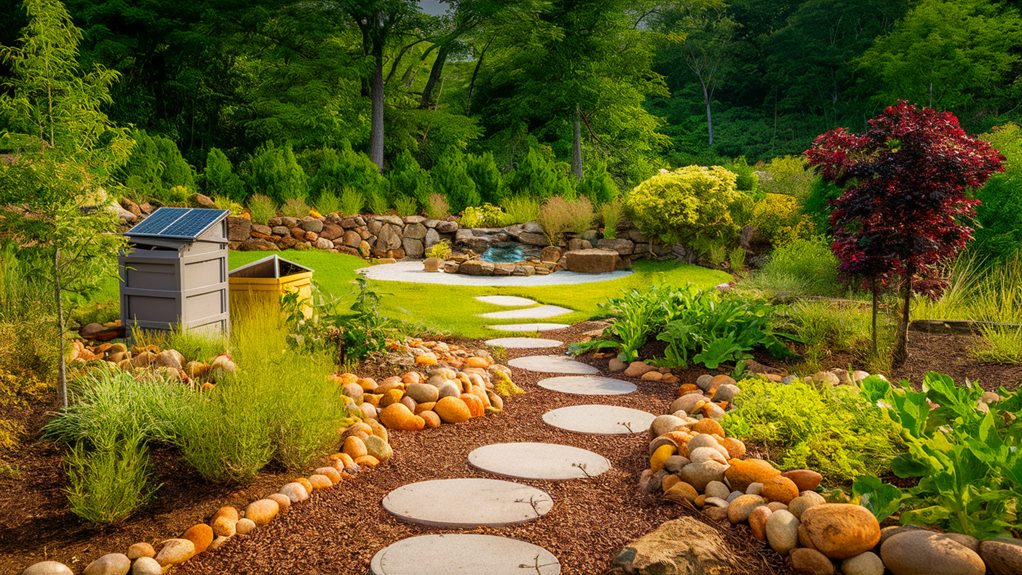Transform your backyard into a sustainable paradise with three eco-friendly landscaping ideas. First, plant a native garden; it attracts pollinators while supporting local ecosystems. Next, install a rainwater harvesting system to capture and store rain, reducing your reliance on municipal water sources. Finally, start composting kitchen scraps and yard waste to enrich your soil, and use organic mulch to suppress weeds. These practices not only create a healthy garden but also contribute to a greener planet. Want to discover more sustainable tips and tricks for your outdoor space? There's a wealth of eco-friendly inspiration waiting for you.
Key Takeaways
- Create a native plant garden to enhance local ecosystems and attract beneficial pollinators like bees and butterflies.
- Implement a rainwater harvesting system to collect and store rainwater, reducing reliance on municipal water sources.
- Incorporate composting practices to enrich soil health and promote a sustainable ecosystem with kitchen scraps and yard waste.
- Use organic mulching materials such as straw or wood chips to suppress weeds while improving soil structure and moisture retention.
- Consider permeable paving in your landscaping to manage water efficiently and add aesthetic value to your outdoor space.
Native Plant Gardens

Native plant gardens are an excellent way to enhance your landscape while supporting local ecosystems. When you choose native plants, you're not just beautifying your yard; you're creating essential wildlife habitats that foster biodiversity. By planting species that naturally thrive in your region, you'll attract local pollinators, like bees and butterflies, which are crucial for maintaining healthy ecosystems.
Additionally, incorporating organic fertilizers, such as burpee natural purpose granular, can provide necessary nutrients while promoting soil health. Imagine walking through a vibrant pollinator garden, alive with buzzing and fluttering creatures, and knowing you've made a difference!
Moreover, native plants are typically low-maintenance and require less water, making them perfect for water conservation efforts. These resilient plants are adapted to your area's climate, which means they can withstand droughts and heavy rains better than non-native species. This adaptability contributes to overall climate resiliency, allowing your garden to flourish even in changing weather patterns.
As you cultivate your native plant garden, you'll find a sense of belonging in your community. You're joining a movement that values sustainability and environmental stewardship. You'll connect with nature and your neighbors, sharing tips and experiences that enrich everyone's understanding of local ecosystems.
Rainwater Harvesting Systems

Implementing a rainwater harvesting system can significantly reduce your dependence on municipal water sources while promoting sustainable practices in your landscape. By capturing and storing rainwater, you can create a more resilient backyard that supports your plants and conserves valuable resources. Additionally, using eco-friendly materials in your landscaping, such as biodegradable wraps, can further enhance your dedication to sustainability.
Start by setting up a rain barrel or a cistern connected to your gutters. This simple addition can gather runoff from your rooftop gardens, providing you with free, untreated water for irrigation. Pair this with water-efficient irrigation systems to make certain your plants receive just the right amount of moisture without wasting a drop.
Plus, when you integrate greywater recycling—reusing water from sinks, showers, or laundry—you'll further improve your system's efficiency, creating a truly eco-friendly oasis.
Consider incorporating permeable paving in your outdoor spaces. This technique allows rainwater to seep through, reducing runoff and replenishing groundwater. It's a clever way to manage water while adding beauty to your landscape.
Don't overlook that a well-designed rainwater harvesting system can be part of a larger ecological vision. By fostering connections with neighbors who might be interested in similar methods, you'll create a community that values sustainability. Share tips on your local gardening forums or organize workshops to inspire others.
As you immerse yourself in rainwater harvesting, you're not just optimizing your backyard—you're becoming part of a movement that nurtures our planet. Let's create sustainable landscapes together, one drop at a time!
Composting and Organic Mulching

Composting and organic mulching are game-changers for anyone looking to enrich their garden while embracing eco-friendly practices. By incorporating these methods, you not only enhance the health of your plants but also contribute to a sustainable ecosystem.
Start your composting journey by creating a compost bin, where you can toss kitchen scraps, yard waste, and even grass clippings. This rich organic matter will break down, providing essential nutrients to your garden. To further optimize your composting efforts, consider using compostable trash bags that break down into organic matter, helping to minimize plastic waste in your compost pile.
For an innovative twist, consider worm composting, also known as vermiculture. By introducing red wigglers into your compost pile, you can speed up decomposition and produce nutrient-dense worm castings. These little helpers turn your organic waste into "black gold," a powerful fertilizer that'll boost your plant's growth. Plus, it's a fun activity that connects you with nature—you'll feel a sense of community as you share tips and tricks with fellow gardeners.
Organic mulching is another fantastic way to foster a healthy garden environment. By applying a layer of organic materials such as straw, wood chips, or shredded leaves, you'll suppress weeds, retain moisture, and improve soil structure. Grass clippings are an excellent option too; they break down quickly and enrich the soil with nitrogen.
Frequently Asked Questions
How Can I Attract Beneficial Insects to My Garden?
To attract beneficial insects to your garden, try companion planting. Pairing flowers like marigolds or lavender with your vegetables can draw in pollinators and pest-eaters.
You can also build insect hotels, providing shelter for native bees and ladybugs. These simple additions create a welcoming environment for helpful critters, promoting a balanced ecosystem.
What Are the Best Eco-Friendly Lawn Care Practices?
To practice eco-friendly lawn care, focus on using natural fertilizers that nourish your soil without harmful chemicals.
Embrace water conservation by implementing efficient irrigation systems or rain barrels.
For pest management, opt for organic pest control methods that protect beneficial insects.
Additionally, incorporate native plants to create a resilient ecosystem that thrives in your local climate.
How Do I Create a Pollinator-Friendly Backyard?
To create a pollinator-friendly backyard, start by planting native plants that attract bees, butterflies, and other pollinators.
Design pollinator pathways to connect these plants, making it easy for them to thrive.
Incorporate bee hotels filled with nesting materials to provide safe havens for solitary bees.
What Types of Eco-Friendly Garden Furniture Are Available?
When you're choosing eco-friendly garden furniture, consider recycled materials, biodegradable options, and sustainable designs.
Look for chairs made from reclaimed wood, tables crafted from recycled plastic, or cushions filled with natural fibers.
By selecting furniture that aligns with your values, you're not just enhancing your space, you're also making a positive impact on the environment.
This way, you're creating a backyard that feels inviting, responsible, and in harmony with nature.
How Can I Reduce Energy Consumption in My Garden Lighting?
To reduce energy consumption in your garden lighting, switch to solar-powered lights that harness the sun's energy. You'll save on electricity while enjoying a warm glow at night.
Consider using energy-efficient bulbs for fixtures, too. Install motion sensor lights to illuminate only when needed, and set up timed lighting to turn off automatically after a few hours.
These simple changes make your garden eco-friendlier while creating a welcoming atmosphere for everyone.
Conclusion
So, if you're tired of your backyard looking like it's auditioning for a role in a pesticide commercial, why not embrace these eco-friendly landscaping ideas? You'll save water, attract lovely local wildlife, and even turn your kitchen scraps into gardening gold. Who knew saving the planet could be so stylish? Let's face it, a sustainable backyard is the new black—because nothing says "I care" quite like a patch of native plants and a rain barrel.

